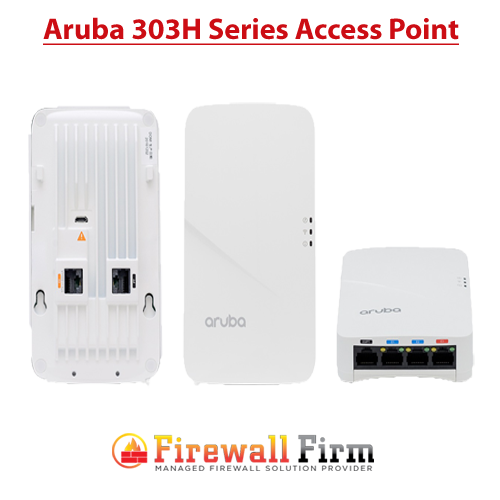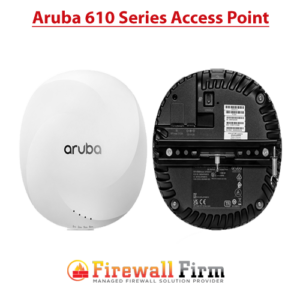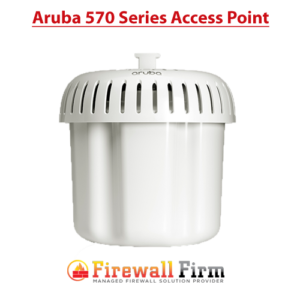Description
Aruba 303H Series Access Point
Overview:
The multi-functional Wave 2 303H access point delivers best-in class Wi-Fi connectivity for hospitality and branch offices, enabling an always-on user experience with low Total Cost of Ownership (TCO).
With a maximum concurrent data rate of 867Mbps in the 5GHz band and 300Mbps in the 2.4GHz band, the 303H AP delivers high-performance Gigabit Wi-Fi for hospitality and branch environments at an attractive price point. It supports multi-user MIMO (MU-MIMO) and 2 spatial streams (2SS) to provide simultaneous data transmission for up to 2 devices, maximizing data throughput and improving network efficiency.
The 303H AP can be easily mounted to a standard data wall-box using the existing structured cabling system or converted to a desk mounted AP using an optional mounting kit. It is ideal for schools (dormitories, classrooms), hotels, medical clinics, branch offices and remote workstations which often require flexible and easy deployment options.The 802.11ac Wave 2 303H AP combines wireless and wired access in a single compact device. Three local Gigabit Ethernet ports are available to securely attach wired devices to your network. One of these ports is also capable of supplying PoE power to the attached device.
Like all other Aruba Wave 2 APs, the 303H AP includes the enhanced ClientMatch™ technology that extends the client steering technology with MU-MIMO client awareness. It automatically identifies MU-MIMO capable mobile devices and steers those devices to the closest MU-MIMO capable Aruba access point to achieve the best WLAN performance in a mixed device environment during the technology transition period.
The integrated Bluetooth Aruba Beacon in the 303H AP simplifies the remote management of a large scale network of battery-powered BLE Aruba Beacons while also providing advanced location and indoor wayfinding, and proximity-based push notification capabilities.)
CHOOSE YOUR DEPLOYMENT AND OPERATING MODES
Aruba Unified APs offer a choice of deployment and operating modes to meet your unique management and deployment requirements:
- The 303H AP is a unified AP that supports both controller-based and controllerless deployment modes, providing maximum flexibility
- Controller-based mode: When deployed in conjunction with an Aruba Mobility Controller, Aruba APs offer centralized configuration, data encryption, policy enforcement and network services, as well as distributed and centralized traffic forwarding.
- Controllerless (Instant) mode: The controller function is virtualized in a cluster of APs in Instant mode. As the network grows and/or requirements change, Instant deployments can easily migrate to controller-based mode.
- Remote AP (RAP) mode for branch deployments
- Air monitor (AM) for wireless IDS, rogue detection and containment
- Spectrum analyzer, dedicated or hybrid, for identifying sources of RF interference
- Secure enterprise mesh
For large installations across multiple sites, the Aruba Activate service significantly reduces deployment time by automating device provisioning, firmware upgrades, and inventory management. With Aruba Activate, APs in Instant mode can configure themselves when powered up.
303H ACCESS POINT SPECIFICATIONS
- Unified dual-radio 802.11ac Wave 2 2×2:2 hospitality and branch AP with internal antennas, three local Gigabit Ethernet ports, PoE out and USB host interface
- Supports wall-box and desk mount deployments
WI-FI RADIO SPECIFICATIONS
- AP type: Indoor, dual radio, 5GHz 802.11ac 2×2 MIMO and 2.4GHz 802.11n 2×2 MIMO
- Software-configurable dual radio supports 5GHz (Radio 0) and 2.4GHz (Radio 1)
- 5GHz: Two spatial stream Multi User (MU) MIMO for up to 867Mbps wireless data rate to up to two (1×1 VHT80) MU-MIMO capable client devices simultaneously
- 5GHz: Two spatial stream Single User (SU) MIMO for up to 867Mbps wireless data rate to individual 2×2 VHT80 client devices
- 2.4GHz: Two spatial stream Single User (SU) MIMO for up to 300Mbps wireless data rate to individual 2×2 HT40 client devices
- Support for up to 256 associated client devices per radio, Supported frequency bands (country-specific restrictions apply):
- 2.400 to 2.4835GHz
- 5.150 to 5.250GHz
- 5.250 to 5.350GHz
- 5.470 to 5.725GHz
- 5.725 to 5.850GHz
- Available channels: Dependent on configured regulatory domain
- Dynamic frequency selection (DFS) optimizes the use of available RF spectrum
- Supported radio technologies:
- 802.11b: Direct-sequence spread-spectrum (DSSS)
- 802.11a/g/n/ac: Orthogonal frequency-division multiplexing (OFDM)
- Supported modulation types:
- 802.11b: BPSK, QPSK, CCK
- 802.11a/g/n/ac: BPSK, QPSK, 16-QAM, 64-QAM, 256-QAM
- Transmit power: Configurable in increments of 0.5 dBm
- Maximum (conducted) transmit power (limited by local regulatory requirements):
- 2.4GHz band: +18 dBm per chain, +21 dBm aggregate (2×2)
- 5GHz band: +18 dBm per chain, +21 dBm aggregate (2×2)
- Note: conducted transmit power levels exclude antenna gain. For total (EIRP) transmit power, add antenna gain
- Advanced Cellular Coexistence (ACC) minimizes interference from cellular networks
- Maximum ratio combining (MRC) for improved receiver performance
- Cyclic delay/shift diversity (CDD/CSD) for improved downlink RF performance
- Short guard interval for 20MHz, 40MHz and 80MHz channels
- Space-time block coding (STBC) for increased range and improved reception
- Low-density parity check (LDPC) for high-efficiency error correction and increased throughput
- Transmit beam-forming (TxBF) for increased signal reliability and range
- Supported data rates (Mbps):
- 802.11b: 1, 2, 5.5, 11
- 802.11a/g: 6, 9, 12, 18, 24, 36, 48, 54
- 802.11n (2.4GHz): 6.5 to 300 (MCS0 to MCS15)
- 802.11n (5GHz): 6.5 to 450 (MCS0 to MCS23)
- 802.11ac: 6.5 to 867 (MCS0 to MCS9, NSS = 1 to 2 for VHT20/40/80)
- 802.11n high-throughput (HT) support: HT 20/40
- 802.11ac very high throughput (VHT) support: VHT 20/40/80
- 802.11n/ac packet aggregation: A-MPDU, A-MSDU
OTHER INTERFACES
- Uplink: 10/100/1000BASE-T Ethernet (RJ-45, back)
- Auto-sensing link speed and MDI/MDX
- 802.3az Energy Efficient Ethernet (EEE)
- PoE-PD (input): 48 Vdc (nominal) 802.3af/at PoE
- Local: Three 10/100/1000BASE-T Ethernet (RJ-45, bottom)
- Auto-sensing link speed and MDI/MDX
- 802.3az Energy Efficient Ethernet (EEE)
- One port: PoE-PSE (output): 48 Vdc (nominal) 802.3af PoE
- Passive pass-through interface (two RJ-45, back and bottom)
- Bluetooth Low Energy (BLE) radio
- Up to 4dBm transmit power (class 2) and -93dBm receive sensitivity
- Integrated antenna with moderately directional pattern and peak gain of 0.9dBi
- Bluetooth Low Energy (BLE) radio
- USB 2.0 host interface (Type A connector)
- 3G/4G cellular modems
- Device battery charging port
- Capable of supplying up to 1A/5 watts of power to an attached device
- DC power interface, accepts 1.35/3.5-mm center-positive circular plug with 9.5-mm length
- Visual indicators (LEDs):
- Power/system status
- Radio status
- PoE-PSE status
- Local network port status (3x)
- Reset/LED control button (“paperclip access”)
- Factory reset (when activated during device power up)
- LED control: toggle of/normal
- Serial console interface (custom, uUSB physical jack)
Security
- Integrated wireless intrusion protection offers threat protection and mitigation, and eliminates the need for separate RF sensors and security appliances
- IP reputation and security services identify, classify, and block malicious files, URLs and IPs, providing comprehensive protection against advanced online threats
- Integrated Trusted Platform Module (TPM) for secure storage of credentials and keys
Networking on a budget
With the integrated BLE and supporting 802.3af power, the Series APs enable enterprises to improve their work efficiency and productivity with the lowest TCO. When Ethernet drops are not available, VPN tunnels extend remote locations to corporate resources and wireless mesh connections.
Highly secure and reliable performance
The Series APs offer improved network simplicity and security in several ways. Dynamic Segmentation automatically enforces real-time, device-level access policies on Aruba wired and wireless networks. Additionally, Aruba AppRF technology leverages deep- packet inspection to classify and block, prioritize, or limit bandwidth for over 2,500 enterprise apps or groups of apps.
Flexible management options
Available management solutions include Aruba Central (available in cloud-managed and on-premises options), as well as Aruba AirWave, which supports multi-vendor networks. APs can be deployed with zero-touch provisioning to reduce deployment time, centralize configuration, and simplify inventory management.
Aruba Access Point
| Aruba Indoor Access Point | Aruba Outdoor Access Point
Aruba EX370 Series Access Point Aruba EX560 Series Access Point |
Aruba Remote Access Point
Aruba 203R Series Access Point |
Buy Aruba Access Point online from Firewall Firm’s IT Monteur Store
 Firewall Training in India Cyber Security Training & Firewall Training Provider in India
Firewall Training in India Cyber Security Training & Firewall Training Provider in India















